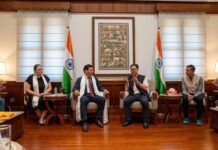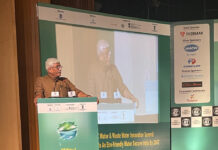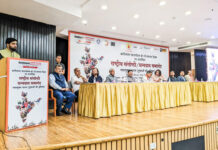| Dr M Rajeevan, Secretary, MoES and Dr Harsh Vardhaninaugurating the NCEAR report |
New Delhi (India Science Wire): In exchange for one rupee spent by the National Monsoon Mission of the Ministry of Earth Sciences and high-performance computing programs, the country will receive an economic benefit of fifty rupees over the next five-year period, which is 50 times more than the investment made, says the National Council of Applied Economic Research 2020 (NCAER). This report was released by Dr Harsh Vardhan, Minister of Science and Technology, Health and Family Welfare and Earth Sciences at a function held at Nirman Bhawan, New Delhi.
The NCAER report mentions economic benefits in the country as direct monetary benefits to crop farmers, cattle rearers and fishermen. The key findings of the report say that 82% of fisherman reported using Ocean State Forecast (OSF) advisories every time before venturing into the sea and 87.7% of fishermen are using these advisories on daily basis as compared to just 15.1% for 2015. The fishermen are following the OSF advisories before venturing into the sea. There are 95% of them reported having avoided empty trips by following the advisories which helped them save Rs 18.25 crores of operational cost. And in addition to these, Rs 1.92 crore additional income was generated from the 1,079 successful fishing expeditions made using the ‘Potential Fishing Zone Advisories’.
According to the report, India’s investment of around Rs 1,000 crore in National Monsoon Mission and high-performance computing facilities has brought a profit of nearly Rs 50 thousand crore to 10.7 million. This will benefit the Below Poverty Line (BPL) agricultural households and 0.53 million BPL fishermen families.
“The total annual economic benefit to 10.7 million Below Poverty Line farmers and livestock owners was 13,331 crores if this is converted into incremental benefits for five years it becomes 48,056 crores. And for the BPL fishermen households, the annual income gained by 0.53 million is 663 crores for five years it becomes 2,391 crores and that makes it 50,447 crores” said Dr Harsh Vardhan while releasing the report.
The NCAER study was based on a survey of 6,098 respondents, including 3,965 crop farmers, 757 marine fishermen and 1,376 animal owners. In addition, responses from 2 lakh farmers were also collected through the Interactive Voice Response System (IVRS) to validate the findings of the Rubaru survey. Data from the period before and after the monsoon were included, which helped to analyze the production and yield of major crops before and after the implementation of the National Monsoon Mission (which took place in 2015). A study on a total of 173 districts (out of a total of 29) in 16 states (out of a total of 732 districts in India) was considered to properly represent agro-aquatic areas, rainfed areas, coverage of major crops, anomalous weather in the country.
The National Monsoon Mission was launched in 2012 with an objective to improve weather and climate forecasts over the country in all time scales. The first phase of the monsoon mission was for the period 2012-2017 and now the second phase of the mission is underway. Through the monsoon mission, MoES could establish the state of the art dynamical models for weather and climate forecasts. It was developed as a state-of-the-art, dynamic monsoon forecasting system for forecasting short, medium, and long-term rainfall. (India Science Wire)















